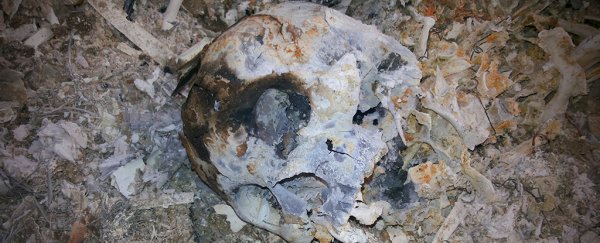Long after your flesh is dust and your stories forgotten, your bones will whisper secrets about your life. Future archaeologists will wring out truths about your health, your past, and your place in society.
Many of these clues can vanish if our remains are split and warped by the heat of cremation, but a new technique for picking out subtle hints of sex in skeletal fragments could provide researchers with new insights into old bones.
A new way to estimate sex based on physical characteristics of cremated bones is claimed by its creators to be 80 percent effective, which is actually about as accurate as current methods used for analysing intact skeletons.
"This is a new method for supporting the sex determination of human cremated remains in antiquity," says biological anthropologist Claudio Cavazzuti of Durham University.
"Easy, replicable, reliable."
Ignoring for a moment the sociological versus biological implications for sex and gender, humans are a sexually dimorphic species. Signature differences in our skeletons can generally be categorised according to male and female characteristics.
Even under ideal circumstances, however, putting this process into practice can be easier said than done. For remains that have been broken up – or worse, altered by heat – those signatures can prove virtually impossible to read.
That means there are few tools available to researchers wishing to identify the probable sex of a body reduced to splinters and ashes centuries ago.
Cavazutti and his colleagues have found though that it's still possible to pick out robust clues, if you know where to look.
The team gathered the cremated remains of 124 individuals from five different Bronze and Iron Age cemeteries across Italy, each coming from a grave containing a sample of remains believed to provide a strong indication of gender.
They then examined dozens of variables, such as the thickness of jawbones, height of knee caps, and maximum width of big toe bones.
Of these traits, most were no longer useful at distinguishing the attributed sex, due to changes in shape or structure caused by deformation.
But eight characteristics retained enough information to still prove surprisingly accurate.
The best measurements for the job could be found on the thigh, upper arm, lower arm (radius), knee cap, jaw, parts of the ankle and the wrist, and the big toe, each of which could predict the nature of the grave goods more than eight times out of 10.
Of course, there are some big assumptions in play. The anthropology of sex is complicated. From the possession of a Y chromosome to the culture of gender, there's a world of variables to keep in mind.
Having a spindle in your grave isn't proof positive that you're a woman, just as owning weapons doesn't always make for convincing evidence that the grave belongs to a male.
There's also a need to take time and geography into account. The team points out that the cut-offs used to distinguish the sex of early historic remains differ to methods used to sort modern skeletons. Mixing up methods gets completely different results.
Still, tools like these are incredibly useful with a large enough sample population to learn from, and caveats firmly in place.
Combined with supporting evidence and a critical eye for culture, this new method provides anthropologists with additional data points to weave a likely story for the owner of a grave reduced to shattered bones.
This research was published in PLOS One.
